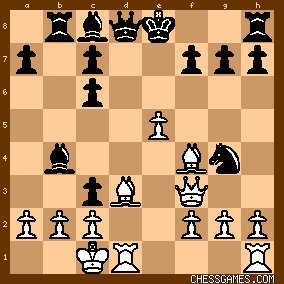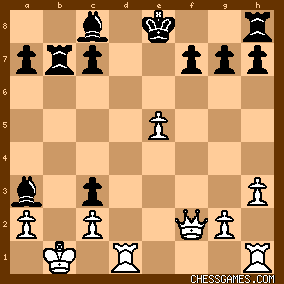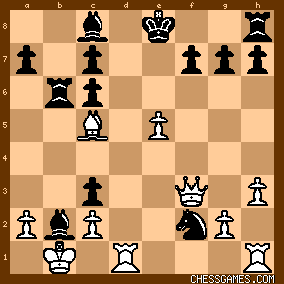|
< Earlier Kibitzing · PAGE 2 OF 2 ·
Later Kibitzing> |
| Dec-29-13 | | abuzic: 16.Bg5
16...Qxe5 17.Qf7#
16...Qf8 17.Rd8#
16...f6 17.exf6 Nxd1 <17...gxf6 18.Qh5+ Kf1 19.Bh6+, and mate next> 18.fxg7 Qxg7 19.Qe4+ Kf8 20.Rf1+, nothing can stop white mating. 16...Rxb3 17.Qxc6+ Qd7 <17...Bd7 18.Qa8+> 18.Rxd7 0-0 19.cxb3 Bxd7 20.Qxd7 Nxd1 21.Be7 |
|
| Dec-29-13 | | Amadori: The whole game is insane. Horvath was in a bit of a pickle after the knight gambit (if that's what it was) at 9 ..d4 - 11.O-O-O. Perenyi was 19 at the time. Must have stung to be beaten by a 15 yr old. |
|
Dec-29-13
 | | al wazir: I got the first move, but never dreamed that black would reply 16...Rxb3. OTB I would then have played 17. Qxc6+, which wins handily. (If 17...Bd7, then 18. Qa8+; if 17...Kf8, then 18. Bxe7+, followed by a ♔ hunt.) |
|
| Dec-29-13 | | M.Hassan: "Insane"
White to play16.?
White is down by a Knight and two pawns and white could become two pawns down by capturing the black Knight but there is a better move:16.Bg5
<if...Qxg5 17.Qxf7#>
<if...Qf8 or...Qe6 17.Rd8#> 16.........f6
17.exf6 gxf6
18.Rhe1 Be6
19.Rxe6 fxg5
20.Rxe7+ Kxe7
21.Qf7#
I think Black looses even if he let go of his Queen:
16.Bg5 0-0
17.Bxe7 Re8
18.Qxf7+ Kh8
19.Qxe8#
Time to check |
|
| Dec-29-13 | | The17thPawn: <Dezaxa> - I concur 15...,Rxb3 looks like the better try. |
|
| Dec-29-13 | | Cheapo by the Dozen: I think I may have actually gotten this one.
White is down a piece and some pawns. Black has a hanging knight, which happens to have White's rooks forked. Black also has serious threats against White's king position. With that as backdrop, the obvious try is 16 Bg5. Black's queen can't capture or move in response, due to the dual mate threats at f7 and d8.
16 ... Nxh8 (or d8)
17 Bxe7 Kxe7, also falls to mate, while other 17th moves in that line leave Black down in material. So the only serious attempt I see at defense is
16 Bg5 f6
17 ef, attacking the queen two ways (if you count the pin). Letting the queen go indeed leaves Black in a lost position, e.g.
16 Bg5 f6
17 ef gf
18 R(h)e1+ Qxe1
19 Rxe1+
But running away is even worse, as in
16 Bg5 f6
17 ef Qe5
18 fg, threatening both mate at d8 and gxh8+(Q). |
|
| Dec-29-13 | | Cheapo by the Dozen: Oops. I missed the Rxb3 defense.
Why not 18 ... Rxb4?
19 Qxc6+ Kf8
20 Qc5+ Ke8
21 Qxb4 Nxh1
looks defensible for Black at first blush. |
|
| Dec-29-13 | | Cheapo by the Dozen: So Black resigned because Qxc7, with the pin, will yield White a queen plus a rampaging attack for 2 pieces and some pawns? Even if Black can stave off quick mate, White will surely gobble up some material. |
|
| Dec-29-13 | | RandomVisitor: As mentioned earlier, Black missed an opportunity after 15.Kb1
click for larger view Rybka 4.1 x64:
<[-2.67] d=16 15...Rxb3> 16.axb3 0-0 17.Rd4 Nxe5 18.Qe4 f6 19.Re1 Qc5 20.Be3 Qb5 21.f3 a5 22.f4 Nf7 23.Qe7 Qb7 24.Qc5 Nd6 25.Bc1 Bxc1 26.Kxc1 Nb5 27.Rc4 Bd7 |
|
| Dec-29-13 | | RandomVisitor: After 11...Rb8:

click for larger view Rybka 4.1 x64:
<[+0.32] d=16 12.Bf5> Qe7 13.Bxc8 Rxc8 14.Qxg4 cxb2+ 15.Kb1 0-0 16.Rd7 Qe8 17.Rhd1 Rb8 18.Be3 h5 19.Qxh5 Bd6 20.Qg4 Rb4 21.Bd4 Bxe5 22.c3 Rb5 23.c4 Ra5 24.Re1 g6 25.Qh3 Kg7 |
|
| Dec-29-13 | | RandomVisitor: After 15...Nxf2:

click for larger view Rybka 4.1 x64:
<[+7.99] d=15 16.Bg5 Rxb3 17.Qxc6+> Qd7 18.Rxd7 0-0 19.cxb3 Bxd7 20.Qxd7 Nxh1 21.Be7 Rb8 22.Qxc7 Ra8 23.e6 fxe6 24.Qb7 Re8 25.Qd7 Ra8 26.Bd8 Rxd8 27.Qxd8+ Kf7 28.Qc7+ Kf8 29.Qh2 Ba3 30.Qxh1 Be7 31.Kc2 |
|
Dec-29-13
 | | Richard Taylor: First I thought it was Bg5 but I saw the Rxb3 and Rb7 idea thinking that black would or might be lost after Bc5. I missed Bc4! But White had a better win with 17. Qxc6! But I also had Qxc6+ missing that after the sac on d7 and Bg5+ the King escapes to c8 (forgetting the B had moved). I think I would have played Bg5.
But I cant say I solved it although I think I saw the main tactical and attacking ideas. Very ingenious play by White! |
|
Dec-29-13
 | | Richard Taylor: Bb4! I meant...(You can see I could never play blindfold chess.) |
|
Dec-29-13
 | | Richard Taylor: What a crazy slaughterous game!! A lot of my 3 minute games are like this!! (And quite a few of my OTB games, but I sacrifice first and then see if it works afterwards - often it doesn't!) |
|
| Dec-29-13 | | morfishine: Wednesday-ish in its simplicity: <16.Bg5> As mentioned by others, 15...Rxb3 is much better for Black due to 16.axb3 Qa5 or 16.cxb3 Bf5+; Since the rook is immune, Black is now up two pieces, so White's best is 16.hxg4; but after 16...Rb6, I don't see how White can hold the position ***** |
|
| Dec-29-13 | | goodevans: <morfishine: Wednesday-ish in its simplicity> It's certainly not insane. <16.Bg5> is an obvious candidate and you only need to figure two things to confirm its effectiveness: (1) the black Q is rooted to e7/f6 through mate-in-1 threats on d8 and f7; and (2) <16...f6 17.exf6> leaves black in a whole load of pain because <17... gxf6> loses to <18.Qh5+>. So just two factors to consider to see that 16.Bg5 wins the black Q. What makes it a bit trickier than the average Wednesday puzzle, though, is spotting that black can create a drawing threat by opening the b-file (but isn't <17...Rb6> better than <17...Rb7>?). To get full marks you need to see that <18.Bb4> stops this without dropping the piece (<18...Rxb4 19.Qxc6+> wins the R). That was the hardest part of today's puzzle.> |
|
| Dec-29-13 | | agb2002: White is one knight and two pawns down.
Black threatens 16... Nxd1, 16... Nxh1, 16... O-O and has the resource ... Rxb3. For example, 16.Qxf2 Rxb3 17.cxb3 (17.axb3 Qa3 - +) 17... Bf5+ wins the white queen. The obvious 16.Qxc6+ Bd7 (16... Kf8 17.Bg5 Qxg5 18.Qxc7 with the threats 19.Qxf7#, 19.Rd8+, 19.Qxb8) 17.Rxd7 Qxd7 18.Bxf7+ Kd8 19.Bg5+ Kc8 20.Be6 Ba3+ and perpetual, 21.Bb3 is not possible due to 21... Qxc6. 16.Bg5 is probably the only winning move for White:
A) 16... Qxg5 17.Qxf7#.
B) 16... Nxd1 17.Bxe7
B.1) 17... Kxe7 18.Qxf7+ Kd8 19.Rxd1+ Bd7 20.Qxd7#.
B.2) 17... Rxb3 18.Qxd1 Kxe7 19.axb3 + - [Q vs 2B+2P]. C) 16... Nxh1 17.Bxe7 Be6 (17... Kxe7 18.Qxf7#; 17... Rxb3 18.axb3 Kxe7 19.Rxh1 as in B.2) 18.Bd4 with many threats (Qxc6+, Rxh1, Qd3, etc.) looks winning. D) 16... Rxb3 17.Qxc6+ Kf8 (17... Bd7 18.Qa8+ and mate in three) 18.Bxe7+ Kxe7 19.axb3 + -. E) 16... f6 17.exf6
E.1) 17... gxf6 18.Qh5+ Kf8 18.Bh6+ Qg7 19.Qf7#.
E.2) 17... Rxb3 18.fxe7 (18.axb3 Qa3 is unnecessarily risky) with the double threat 19.Rd8# and 19.axb3. E.3) 17... Nxd1 18.fxe7 Rxb3 19.Rxd1 is similar to E.2. |
|
Dec-29-13
 | | Penguincw: This is the closest I ever came to solving a Sunday puzzle. I got 16.Bg5 right, knowing that if 16...Qxg5 17.Qxf7# 1-0. Also, if 16...Nxd1 17.Bxe7 Kxe7 (17...Nf2 18.Qxf7+ Kd7 19.Be6# 1-0) 18.Qxf7+ Kd8 19.Rxd1+ Bd7 20.Qxd7# 1-0 I also had thoughts of 17.Qxc6+ if moves like 17...Qf8 were to occur. However, I didn't calculate or even expect that "exchange sac". |
|
Dec-29-13
 | | paulalbert: That 16 Bg5 was the start was fairly obvious creating two focal mating points, d8 and f7, but I didn't even consider the 15… Rxb3 defense try with the perpetual check idea. 18 Bb4 was a really nice solution, followed by e6 and then the Q excursion with all the threats. Perhaps not totally insane for the very strong, but I certainly could not visualize all these ideas at the starting position of this puzzle. |
|
| Dec-29-13 | | WoodPushkin: Greetings:
16. Bg5.
While I know my game is improving I must say this is an easy puzzle for Sunday. Friday and Saturday's puzzles required greater chess vision and positional analysis. The real lesson in this study is why 12.Bc4 loses for White. Also why is 15...RxBb3 winning for Black?
Going through these ideas improves strategic conceptualization. JAH Love |
|
| Dec-29-13 | | morfishine: <goodevans> You make a lot of good points. However, what disappoints is the disparity in quality of Black's 15th move, comparing what was played to what could've been played. Typically, brilliancies result from some inaccuracy. Here, the difference between 15...Nxf2?? and 15...Rxb3 is striking: Black loses when he could've won ***** |
|
Dec-29-13
 | | Jimfromprovidence: <goodevans>
<To get full marks you need to see that <18.Bb4> stops this without dropping the piece (<18...Rxb4 19.Qxc6+> wins the R). That was the hardest part of today's puzzle.> Yes, nice assessment.
With 17...Rb7, black might have been trying to lure white into the erroneous 18 Qxc6+?, which black responds to with 18...Kxe7. 
click for larger view Now white has no attack and he might even lose the game unless he follows with 19 Qc5+, winning the knight. In doing that he concedes the perpetual after 19...Ke8 20 Qxf2 Ba3+. 
click for larger view If 17...Rb6 instead, then 18 Bc5 wins.

click for larger view |
|
| Dec-29-13 | | InspiredByMorphy: Without any deep analysis, it looks to me as though there were a few more sound moves for black. Moves like 7. ...d6, 9. ...O-O, and 15. ...Nh6. |
|
| Dec-29-13 | | Poisonpawns: Being familiar with Morphy vs Duke of Brunswick/Count of Isouard helped me solve this puzzle in 3 -5 seconds. |
|
| Dec-29-13 | | James D Flynn: 16.e6 Bxe6leads no 17.Bxe6 fxe6 18.Qxc6+ Kf8 19.Bxc7(all moves must be forcing else Ba3+ draws) Rc8 20.Rhf1 Rxc7 21.Rxf2+ Kg8 22.Qa8+ and whichever piece, R or Q interposes will be taken with check, it is therefore mate in 2. |
|
 |
|
< Earlier Kibitzing · PAGE 2 OF 2 ·
Later Kibitzing> |





